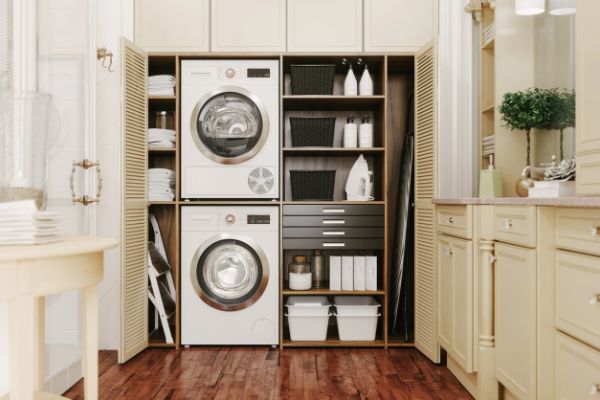In today’s fast-paced world, finding efficient and space-saving solutions for household chores is essential. When it comes to laundry, stackable washer and dryer units have gained popularity for their compact design and convenience.
This blog post will provide an overview of the pros and cons of stackable washer and dryer units, helping you make an informed decision for your laundry needs. By understanding the benefits and drawbacks, you can evaluate whether a stackable washer and dryer is the right choice for your home.
Table of Contents
Pros of Stackable Washer and Dryer
Space-Saving Design
One of the significant advantages of stackable washer and dryer units is their space-saving design. They are designed to be vertically stacked, allowing you to utilize limited laundry room or closet space more efficiently. This is especially beneficial for apartments, condominiums, or smaller homes where space is at a premium.
Compact Footprint
Stackable units have a smaller footprint compared to traditional side-by-side washer and dryer setups. This compact size makes them an ideal choice for narrow laundry rooms or tight spaces, such as closets or bathroom corners.
Easy Installation
Stackable washer and dryer units are relatively easy to install. They typically require minimal modifications to your laundry area and can be conveniently placed in a variety of configurations to suit your space.
Energy and Water Efficiency
Many stackable washer and dryer models are designed to be energy-efficient, helping you reduce utility bills and minimize your environmental footprint. These units often have advanced features such as load sensing, water level adjustment, and high spin speeds, resulting in lower energy consumption and water usage.
Convenience and Accessibility
Having a stackable washer and dryer allows for greater convenience and accessibility. With both appliances stacked, you can easily transfer clothes from the washer to the dryer without the need to bend down or strain your back. This can be particularly advantageous for individuals with mobility issues or those seeking a more ergonomic laundry solution.
Cons of Stackable Washer and Dryer
Capacity Limitations
One of the main drawbacks of stackable washer and dryer units is their smaller capacity compared to traditional models. The compact size means that these units generally have less room for laundry, which can result in more frequent loads or limited space for bulkier items like comforters or large towels. Consider your laundry needs and frequency to ensure the stackable units can accommodate them adequately.
Potential for Noise and Vibration
Stackable washer and dryer units may be more prone to generating noise and vibration compared to standalone models. The stacking arrangement can cause vibrations to transfer between the appliances, potentially resulting in more noise during operation. Look for models with built-in noise reduction features to minimize disturbances.
Limited Customization Options
When opting for a stackable washer and dryer, you may have limited options for customization. Unlike traditional side-by-side units, you cannot choose different models or brands for the washer and dryer independently. This can limit your ability to select specific features or capacities for each appliance.
Accessibility for Maintenance and Repairs
In case of maintenance or repairs, accessing and servicing a stackable unit might be more challenging compared to standalone models. The stacked configuration may require disassembling the appliances to reach the inner components, potentially causing inconvenience and additional costs for professional assistance.
Pros and Cons of Stackable Washer and Dryer
| Pros | Cons |
|---|---|
| Space-Saving Design | Capacity Limitations |
| Compact Footprint | Potential for Noise and Vibration |
| Easy Installation | Limited Customization Options |
| Energy and Water Efficiency | Accessibility for Maintenance and Repairs |
| Convenience and Accessibility |
Conclusion
Stackable washer and dryer units offer a space-saving and convenient laundry solution for homes with limited space. Their compact design, energy efficiency, and easy installation make them attractive options for many households. However, it is important to consider the potential drawbacks as well. The smaller capacity, potential for noise and vibration, limited customization options, and accessibility for maintenance and repairs are factors that need to be taken into account.
Before making a decision, carefully assess your laundry needs and the available space in your home. If space is a premium and you prioritize convenience and efficiency, a stackable washer and dryer unit might be an excellent choice. However, if you have a large household with frequent laundry loads or require specific features for each appliance, you may want to consider standalone models.
When shopping for a stackable washer and dryer, research different brands and models to find one that meets your requirements. Look for units with features such as noise reduction technology, energy and water efficiency, and reliable performance. Read customer reviews and seek recommendations to ensure you select a high-quality and durable unit.
In conclusion, stackable washer and dryer units offer a practical solution for maximizing space and convenience in smaller homes or apartments. While they come with certain limitations, being aware of the pros and cons will help you make an informed decision. Consider your specific needs, evaluate the available options, and choose the washer and dryer configuration that best suits your lifestyle and laundry requirements. With careful consideration, you can find a stackable unit that brings efficiency and functionality to your laundry routine.

